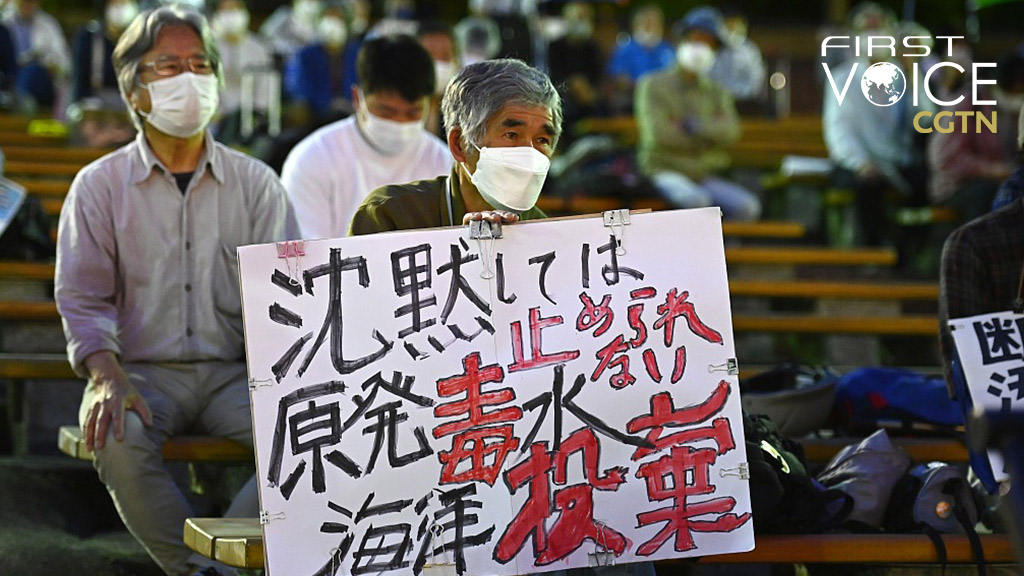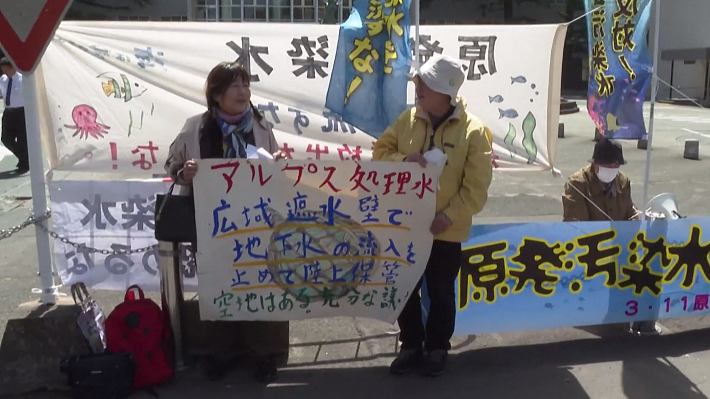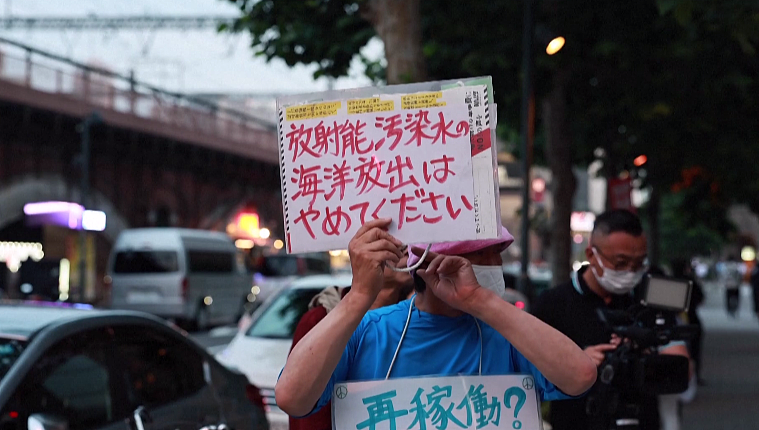
People protest against the plan of the Japanese government and Tokyo Electric Power Company to release the massive radioactive water stockpile from Fukushima nuclear power plant into the sea, Tokyo, Japan, May 16, 2023. /CFP
People protest against the plan of the Japanese government and Tokyo Electric Power Company to release the massive radioactive water stockpile from Fukushima nuclear power plant into the sea, Tokyo, Japan, May 16, 2023. /CFP
Editor's note: CGTN's First Voice provides instant commentary on breaking stories. The column clarifies emerging issues and better defines the news agenda, offering a Chinese perspective on the latest global events.
Tokyo Electric Power Company (TEPCO) announced that facilities used to release the nuclear-contaminated wastewater from the Fukushima Daiichi Nuclear Power Plant into the sea will be put into trial operation on Monday, according to local media outlets. The move is widely seen as a pilot for Japan's formal dumping plan.
After TEPCO sent seawater into an underwater tunnel designed to dump the nuclear-contaminated water into the ocean last week, the marine fish caught in the harbor of the plant were found to have 180 times the maximum limit of the radioactive element caesium allowed in Japan's food safety law.
Despite this worrying result, the International Atomic Energy Agency (IAEA) asserted in a report released on May 31 that TEPCO had demonstrated "capabilities for accurate and precise measurements of the radionuclides present in the treated water stored on site." The report concluded that no additional radionuclides at significant levels were detected. The contradicting findings make the public even more concerned about Japan's dumping plan.
In an interview with Chinese media, Shaun Burnie, an environmentalist who has stayed in Japan for almost 30 years, straightforwardly expressed his disagreement with the IAEA's report. TEPCO has only tested 20 percent of the wastewater tanks, Burnie said. In addition, third-party laboratories in the U.S., Switzerland and South Korea have taken the samples of only 25-liter water (before dilution) each, while there's more than 1.3 million metric tons of nuclear-contaminated water stored in the plant. The amount of samples was unbelievably limited.

People in Fukushima take to the streets to voice their opposition against a government plan to discharge nuclear wastewater from destroyed Fukushima Daiichi Nuclear Power Plant into the sea, April 14, 2023. /CFP
People in Fukushima take to the streets to voice their opposition against a government plan to discharge nuclear wastewater from destroyed Fukushima Daiichi Nuclear Power Plant into the sea, April 14, 2023. /CFP
TEPCO has been telling lies to shirk its responsibilities, and has had a trust deficit for a long time. Co-director of the Nuclear Policy Program at the Carnegie Endowment for International Peace, James M. Acton, and nonresident senior fellow in Carnegie's Nuclear Policy Program, Mark Hibbs, believe the Fukushima Daiichi nuclear accident could have been prevented. "The plant would have withstood the tsunami had its design previously been upgraded in accordance with state-of-the-art safety approaches," the two scholars wrote in an article published on the Carnegie Endowment for International Peace website in March 2012. After the accident, TEPCO has been building discourse to cover up its wrongdoings in the accident, paving the way for its "only" solution of dumping the water into the ocean.
Over the past decade, TEPCO's "dark history" has been constantly exposed, causing shock around the world. Despite strong opposition from governments, citizens, and international environmental organizations, TEPCO insists on proceeding with the ocean discharge of nuclear-contaminated wastewater. Who is endorsing this company that has long had a "negative reputation?" Who is condoning such harmful pollution? And who is the dark force behind TEPCO?
Back in 2013, the Japanese government "nationalized" the Fukushima nuclear accident in order to establish a good national image for hosting the Tokyo 2020 Olympics. Since then, TEPCO's numerous dishonest operations in nuclear-contaminated wastewater treatment have become a "reasonable" means of whitewashing Japan's society as "safe and secure." They collaborated to conceal the truth, even disseminating a significant amount of false information to the media, in order to legitimize and justify the discharge of nuclear-contaminated wastewater into the sea.
Japanese journalist Ryuichi Kino has pointed out that all of TEPCO's investigations lack transparency, and outsiders have no way to verify the completeness and accuracy of the information that is released. Furthermore, the regulatory measures put in place by the Japanese government exist in name only.

A protester holds a placard against Japan's nuclear-contaminated wastewater discharge plan in front of TEPCO headquarters in Tokyo, Japan, June 7, 2023. /CFP
A protester holds a placard against Japan's nuclear-contaminated wastewater discharge plan in front of TEPCO headquarters in Tokyo, Japan, June 7, 2023. /CFP
More shockingly, Japan – driven by the international "nuclear interest chain" – has clung to the United States. The Japan-U.S. alliance is playing a high-stakes game, aiming to exploit the nuclear accident to solidify and deepen the strategic relationship of the Western alliance in the context of the "new Cold War."
The nuclear accident occurred when the Barack Obama administration was readjusting its "pivot to Asia" strategy. Japan also took advantage of the Fukushima disaster to establish an institutionalized incident response protocol framework with the U.S., repairing the damaged diplomatic relationship between the Democratic Party's Yukio Hatoyama administration and the U.S. through a "friendship in action" approach.
Since then, Japan has not only relied on the support of the U.S. to gain international support for its dumping plan. It has also exacerbated the competitive relationship between major powers and turned the issue into a matter of bloc confrontation, using the "new Cold War" and the polarization of the Western alliance as a cover to evade its own international responsibilities. Therefore, whether the Japanese government, backed by hegemonic power, would still care about its "corporate reputation" and "national responsibility" is known to all.
TEPCO, with its notorious track record, is hard to be trusted, and the Japanese government, as its accomplice, has turned this issue into a human catastrophe by endorsing its "reputation." This is the call from the international community: Do not dump the nuclear-contaminated wastewater, which has been "whitewashed" by the Cold War mentality, into the Pacific Ocean!
(If you want to contribute and have specific expertise, please contact us at opinions@cgtn.com. Follow @thouse_opinions on Twitter to discover the latest commentaries in the CGTN Opinion Section.)